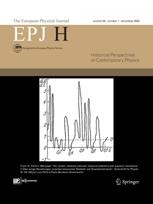Investigating heavy quark physics with the LHCb experiment
In ten years of operation the LHCb experiment has probed the nature of physics attempting to answer some of the Universe’s most fundamental questions. A new review examines its past achievements and future potential.
New York | Heidelberg, 15 April 2021
 A new review published in EPJ H by Clara Matteuzzi, Research Director at the National Institute for Nuclear Physics (INFN) and former tenured professor at the University of Milan, and her colleagues, examines almost three decades of the LHCb experiment – from its conception to operation at the Large Hadron Collider (LHC) – documenting its achievements and future potential.
A new review published in EPJ H by Clara Matteuzzi, Research Director at the National Institute for Nuclear Physics (INFN) and former tenured professor at the University of Milan, and her colleagues, examines almost three decades of the LHCb experiment – from its conception to operation at the Large Hadron Collider (LHC) – documenting its achievements and future potential.
The LCHb experiment was originally conceived to understand the symmetry between matter and antimatter and where this symmetry is broken – known as charge conjugation parity (CP) violation. Whilst this may seem like quite an obscure area of study, it addresses one of the Universe’s most fundamental questions: how it came to be dominated by matter when it should have equally favoured antimatter?
“LHCb wants to study by which mechanism our universe, as we see it today, is made of matter, and how antimatter disappeared despite an initial symmetry between the two states,” says Matteuzzi. “The Standard Model contains a tiny amount of violation of this symmetry, whilst the observation of the universe implies a much larger one. This is one of the most fascinating open questions in the Particle Physics field.”
The LHCb experiment investigates this problem by studying the behaviour of systems and particles made from so-called heavy quarks. These are produced in abundance by highly energetic collisions – explaining why the LHC is the perfect location to study them – and were also abundant in the highly energetic early Universe.
“The field in which the LHCb is active is so-called ‘heavy quarks physics’ which aims to study and understand the behaviour of the particles containing the c and b heavy quarks – usually named charm and beauty quarks,” says Matteuzzi. “The rich sector – spectroscopy – covered by LHCb is how quarks of different types, or flavours, aggregate together to form particles in a way that is analogous to how ‘Up’ and ‘Down’ quarks in different combinations make protons and neutrons.”
“It became clear that the potentiality of the LHCb detector was in other fields beyond the study of CP violation that also hinged on aspects of heavy quark interaction. One was the spectacular success of spectroscopy and the measurement of many new states composed by heavy quarks,” concludes Matteuzzi. “This incredibly rich variety of results is demonstrated in our paper – we hope!”
References: Belyaev I., Carboni G., Harnew N., Matteuzzi C., Teubert F. (2021), The History of LCHb, European Physical Journal H 46, 3 (2021). https://doi.org/10.1140/epjh/s13129-021-00002-z
Further Information
For more information visit: www.epj.org
Services for Journalists
The full-text article is available here.
Contact
Sabine Lehr | Springer | Physics Editorial Department
tel +49-6221-487-8336 | sabine.lehr@springer.com
